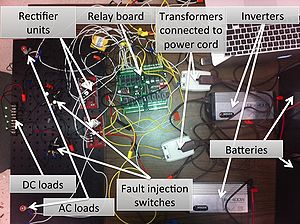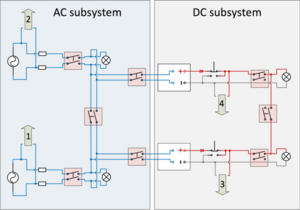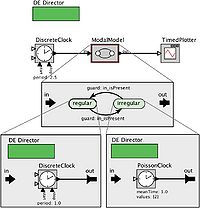SURF 2014: Switching control synthesis in the presence of uncertainty and general loads for an aircraft electric power system testbed
2014 SURF project description
- Mentor: Richard M. Murray
- Co-mentor: Scott C. Livingston
Complex engineered systems are difficult to understand, create, and maintain. A current practical example is control design for vehicle management systems, which broadly refers to the coordination of mechanical, electrical, and computational aspects of the various components of modern vehicles. Concretely, we consider electric power systems on aircraft. Correct operation is crucial for modern designs, yet ensuring that formal requirements are met is very difficult. An aircraft electric power system can be a complex network of different types of generators, loads, and interconnections, all of which vary with time. A control problem in this setting is to decide how to switch contactors "on" and "off" to ensure desired operation.
Toward addressing this, our research group has explored the use of correct-by-construction controller synthesis for switching protocols. Previous work includes development of an aircraft electric power systems testbed [1], to which controllers from the Temporal Logic Planning (TuLiP) toolbox may be applied. The rig and some of its schematic are shown in Figures 1 and 2. Recent work has considered estimating the state of the network in the presence of uncertainty [2]. A next step in the ongoing development of the testbed is representing in and interfacing with the modeling environment Ptolemy II, which provides means for treating multiple notions of time [3].
Possibly making use of Ptolemy II, this SURF project will explore control under more general loads on the aircraft power system testbed. It will be necessary to address practical and theoretical difficulties arising from state uncertainty and interface semantics, among other things.
Possible parts of the project
- Interface the testbed in [1] with software models of other aircraft components, including the heating and air conditioning system. The interface here should be general, so that other types of loads can be added on the aircraft electric power system. Simulations will be developed in Ptolemy II.
- Modularize using FMI, and solve problems concerning time semantics that can occur for hybrid systems represented with functional mock-up units (FMUs) [4].
- Expand the testbed to support experiments involving uncertainty, and conduct such experiments. Begin using techniques from [2].
References
[1] R. Rogersten, H. Xu, N. Ozay, U. Topcu, and R.M. Murray. An Aircraft Electric Power Testbed for Validating Automatically Synthesized Reactive Control Protocols. in Proceedings of HSCC, pp. 89--94. Apr 2013; [DOI][tech report].
[2] Q. Maillet, H. Xu, N. Ozay, and R.M. Murray. Dynamic State Estimation in Distributed Aircraft Electric Control Systems via Adaptive Submodularity. in Proceedings of CDC. Dec 2013; [preprint].
[3] S. Tripakis, C. Stergiou, C. Shaver, and E.A. Lee (2013). A modular formal semantics for Ptolemy. Mathematical Structures in Computer Science, 23: 834--881; [DOI][tech report].
[4] D. Broman, C. Brooks, L. Greenberg, E.A. Lee, M. Masin, S. Tripakis, and M. Wetter. Determinate composition of FMUs for co-simulation. in Proceedings of EMSOFT. Sep 2013; [ACM DL].


